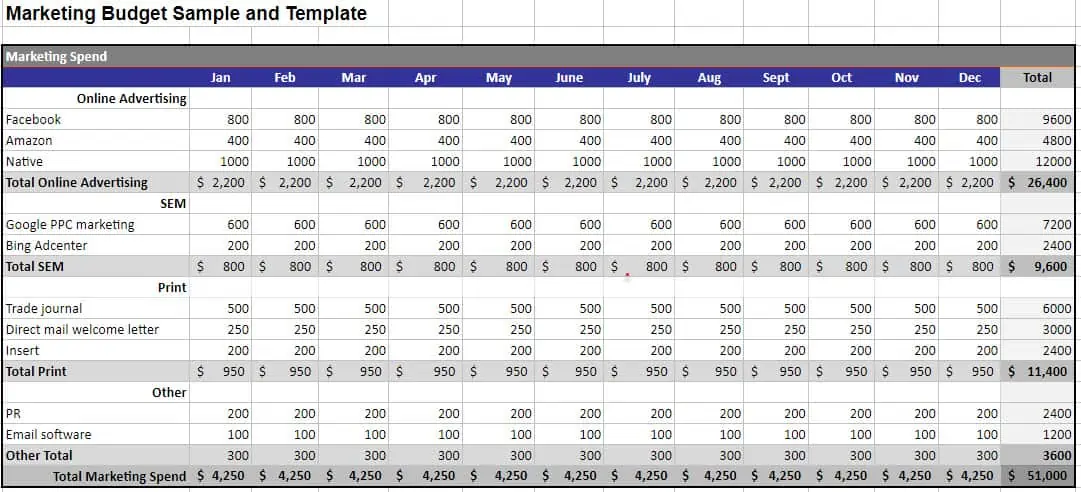Growth Marketing: 4 Core Markets that Need to be in Your Strategy
If you are looking to strengthen your strategic marketing plan, you have come to the right place. In this article, […]
Read More »Become a successful marketing consultant: Learn more

A budget is one of the first steps to getting your marketing department strategy in order.
In fact, realized or not, every company has a budget. Some are proactive and use it to their advantage, while others go about it blindly almost as if they were in a casino hoping for the best roll of the dice.
This tutorial is going to help you build your marketing budget strategically.
Whether you are a one-person operation or have a large marketing department, your budget operates like a rudder in a ship -- helping you to control the direction of your organization based on the resources you have available. Your marketing budget works in union with your marketing strategy, your marketing plan, your 4 P’s of marketing and your marketing calendar.
Additionally, your marketing budget is a core tool to determine the Key Performance Indicators (KPIs) of your marketing strategies and tactics.
Let’s now dig into some methods for building your marketing budget. At the end of this tutorial is a marketing department budget sample, followed by a free template in Google Sheets that you can save (safely and securely) and are free to use and build as your own.
There are four basic ways to determine how much your team will need for marketing in a specific period. While these are guidelines, it's most important to simply get started based on the resources you have available. Over time, your marketing budget will become more clear based on what you spent previously in order to gain results.
This method involves choosing a specific percentage of earnings and using this amount to determine the projects to undertake. This method relies on industry standards and business needs.
Below are recommendations for companies that choose this route.
The formula for this method is:
Marketing budget = Earnings x percentage assigned toward marketing
This method is perhaps the most general as it fails to rely on data driven marketing. The marketing budget will depend on how much the company decides to allocate. Such a technique is not ideal as it might prevent your team from running the campaigns needed to meet your targets. In this case, it would be wise to focus on guerrilla marketing strategies, referral marketing and focused marketing campaigns to get the most from every advertising dollar available (which you should do anyway!)
Competition-matching is another unreliable method of budget allocation. Here, the amount you select will depend on what competitors are doing.
Let’s say your direct competitors are paying most attention to SEO and content marketing for customer acquisition and retention. Therefore, the amount you allocate will be that which would cater to content marketing. While this method can provide you with a starting point, there are a tremendous amount of unknown variables for you to consider if you want to model your competitors spending habits .
It's always important to know what your competitors are doing, price points they charge and value provided. But, unless it's a public company, you have no idea what their financial statements look like, i.e., sales revenue, cost of goods sold (COGS), operating expenses, liabilities, equity, etc -- and even then the numbers may not be reliable for you to make financial resource management decisions.
This approach is ideal as it involves thorough industry research, meaning it’s data-driven. It also involves lots of strategic planning, helping your team set realistic figures.
For example, let's assume your team’s first short term goal is to generate $100,000 in sales revenue from a product you sell for $200.
The job of the marketing department is to gain a customer and keep a customer. And this directly translates to sales revenue. So this is where we will start.
So, the first basic goal is to sell 1,000 units (500 x $200 = $100,000).
But now, in order to set short term and long term marketing goals and determine our marketing budget, we need to factor in an important marketing KPI: cost per sale (CPS).
Cost per sale (CPS) is the cost of the advertisement divided by the number of units sold. For a free template to develop your own cost per lead and cost per sale tracker, based on different sources of leads/sales, go here:
Cost per lead and cost per sale key performance indicator (KPI) marketing template
For example, if you spend $10,000 on Facebook or Google ads and gain 200 sales, then the CPS is $50.
With this, you can now set goals and identify a marketing budget. And the beautiful thing about marketing is that when marketing is done properly and you successfully test small, chances are great that you can scale big because bigger marketing budgets and resources will flow to the successful projects that have more opportunity.
Here is a short term goal: Make $100,00 in sales revenue:
Here is a sample of what a marketing budget looks like:
There are many tools that you can use to build your marketing budget. This marketing budget was constructed in a free online spreadsheet solution called Google Sheets. You can also use Microsoft Excel.
Reserved for readers of Your Strategic Marketing Partner, you can have free access to this spreadsheet by gong here:
Marketing Department Budget Sample and Template (PDF)
You are invited to save the document as your own and construct the marketing budget for your unique needs. Once you save the document as your own you can then save it as a PDF. Or if you want it as it, you can simply save it as a PDF.
If you need help in developing your marketing budget, please feel free to ask as we are happy to help.